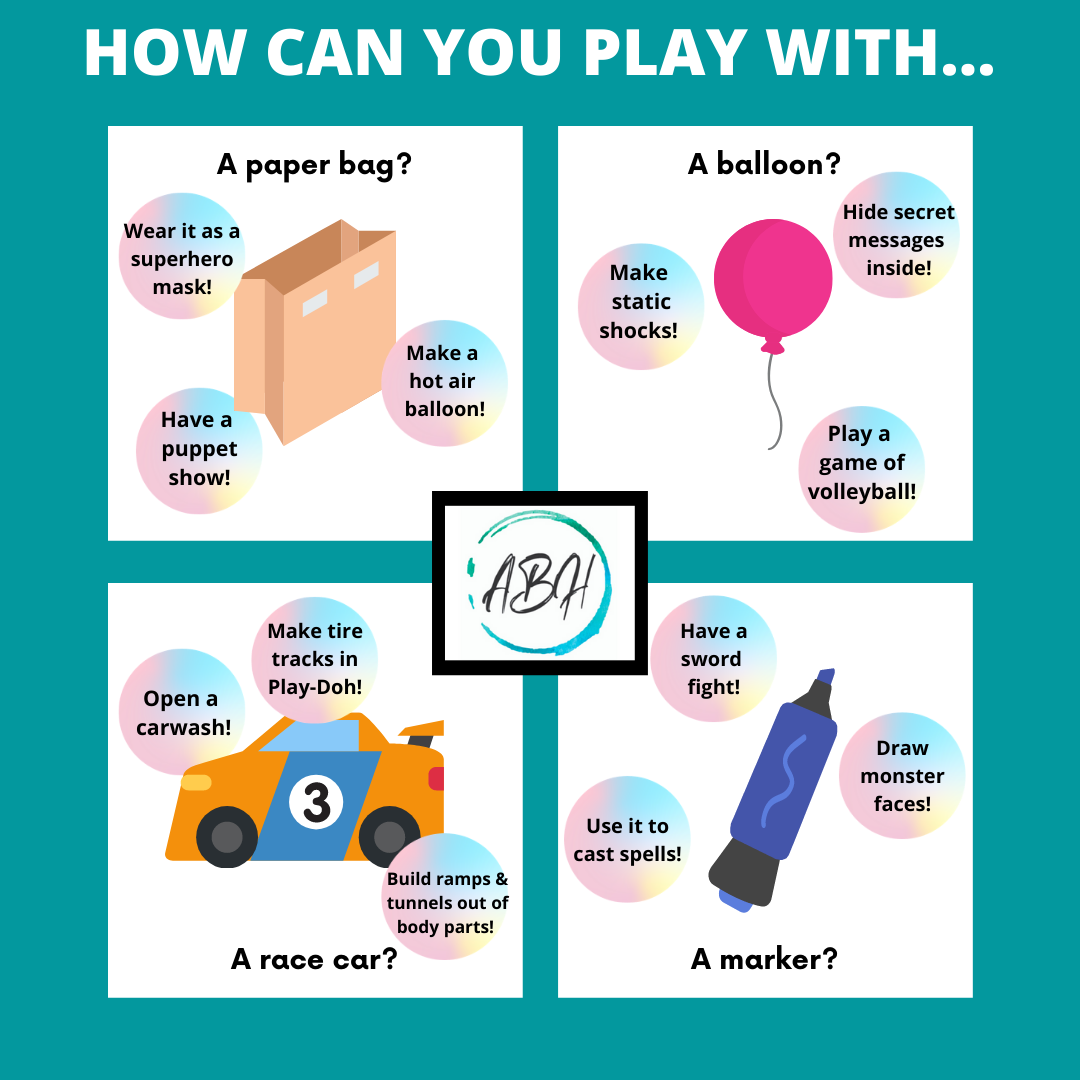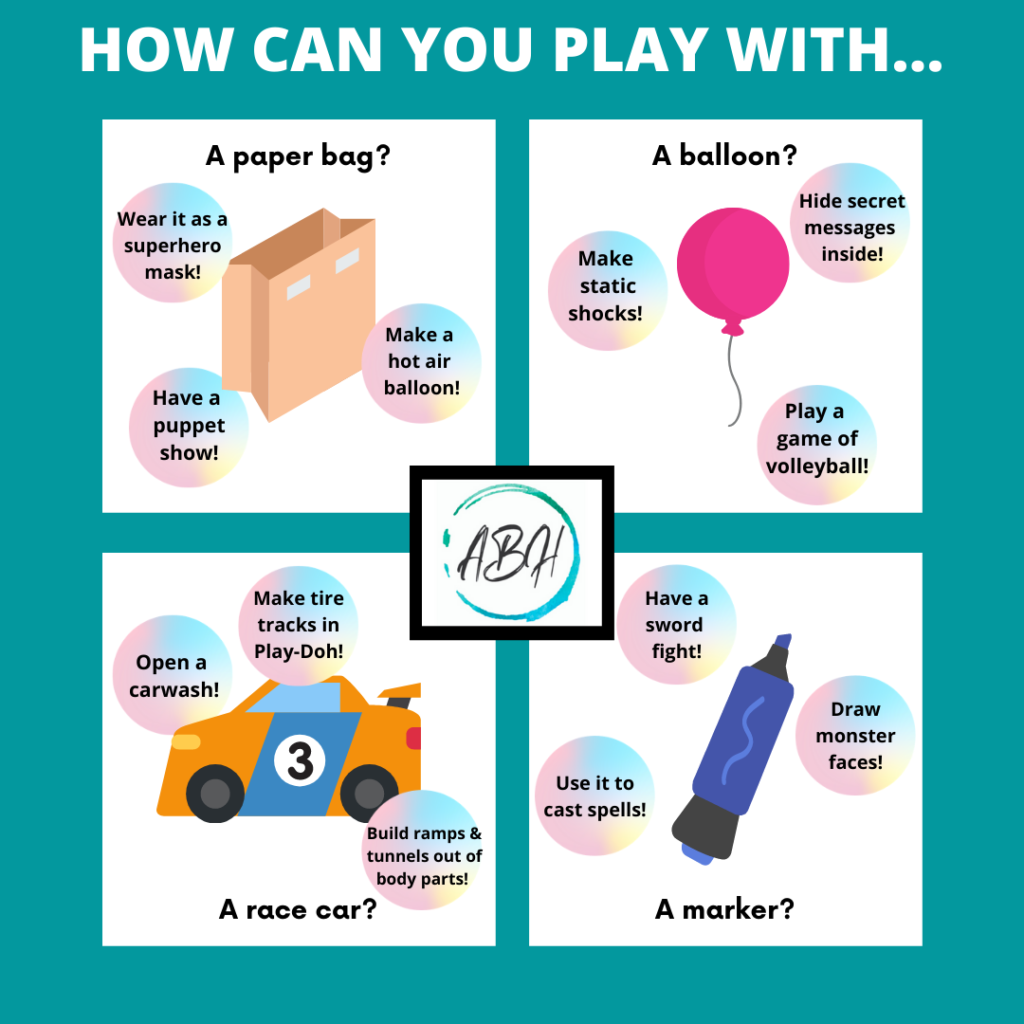This post was written by Carisa Ruiz, MA, BCBA and edited/posted here by Kellie Syfan, M.Ed., BCBA.
Play. It’s something that all kids know how to do in some form or fashion, and sadly something that a lot of adults forget how to do. Do you know how to play like a kid? Whether you’re a parent, RBT, teacher, or babysitter, play is an integral part of forming any kind of relationship with a child.
Lucky for us, kids are usually blunt in communicating whether or not they enjoy playing with you. There’s not a lot of guesswork when a kid straight up tells you, “I want to play by myself,” or, “Stop playing like that,” or my personal favorite, “You’re not as fun as [insert any other name but yours].”
And as much as those words might sting in the moment—trust me, I’ve had my fair share of daggers to the heart—they at least let us know that our play skills could use some work. Here’s some even better news: we can learn how to play like kids again. While many adults forget how to play like a kid, simply because they don’t do it enough, it is a skill that can be retaught, practiced, and improved. Check out 3 skills that we focus on at ABH to improve our play:
Please note that some links contained in this post may lead to products with whom we have a partnership.
If you choose to buy one of these products, we may earn a commission.
#1: BE very, very 100% PRESENT
Practice makes perfect, but only if it’s good practice. Kids often choose the most inconvenient times that they want your attention—when you’re cooking dinner, when you’re on an important business call, five minutes before you need to leave the house. It can turn into a problem but we can get ahead of it!
Set aside time to “practice” playing with your child whenever possible, no matter how short the time. Even 5 or 10 minutes will suffice. Putting it in your schedule might seem formal and unnecessary, but it can make a huge difference.

Rather than giving in and half-trying to play while a hundred other things are going on, carve out time where they have your full attention. In doing so, you can plan when you are able to give your full attention and hopefully make it more likely that when you do need to get things done, they’ll be happy to play alone.
#2 embrace the silliness and the weirdness

Kids love weird stuff. Want proof? Take a hard look kids’ TV shows. Animals and inanimate objects that talk with no explanation. School buses that defy all laws of science. Super powers based on pajamas. Foxes with kleptomania. Kids don’t care if it isn’t logical because it’s entertaining, imaginative, and fun. So it’s our job during play to be entertaining and fun.
One of the best techniques I use to get even the shyest kids to approach me is to make a dang fool of myself. Rolling on the floor, over-the-top reactions, silly faces and voices, losing to them in grandiose fashion, pretending to trip and fall…I have absolutely no shame in the game when it comes to getting a kid to enjoy playing with me, and neither should you.
#3 think outside the box while following two simple rules
Another thing that can get grown-ups in trouble when playing with kids is having tunnel vision about the way toys are supposed to be played with. The tea set is for having tea parties, the Legos are for building, and the basketball is for shooting into the hoop. When those ideas don’t sound appealing to a kid or get boring, and those are the only toys you have to work with, you can feel stuck pretty quickly.
One way to avoid getting stuck is to challenge yourself to use toys in creative ways. How many different ways can you play with Legos? Once you get past the obvious answers like building cars and towers, what other ideas are there? You can use them as ‘tea’ for a tea party, stamps for paint, to create a lava floor obstacle course, as breadcrumbs for a treasure hunt, and much more.

There are two important things to remember when practicing creative play:
- Avoid judging your own ideas before you share them. Pre-judging your ideas before you share them inhibits your ability to come up with more ideas because you’re too busy thinking about how bad your ideas are! At the end of the day, it matters more if your kid thinks the idea is fun—it’s better to share 99 bad ideas to get to one good idea than not share at all.
- Follow your child’s lead. If you happen to come up with a creative idea that you think is fun and your child gets inspired and thinks of a totally different idea, roll with it! The important part is that they are engaged, not that they think your idea is the best one.

bonus: tools to help inspire you to play like a kid!
Have you checked out our resources page? There is an entire section on tools that are helpful for creating and enjoying play. Here is just one example:
Green Kid Crafts Science & Craft Subscriptions for kids ages 2-10
This subscription box mixes STEM learning with play, creativity, and crafts. If you need a little boost and some play tools to help you feel inspired to engage in play with you kids, a subscription box like this can be really helpful because new, useful tools are delivered to your home every month. It’s like play inspiration magic!
Here is a coupon to get you started:
Join today, and save 10% on any new subscription.

in conclusion: have fun!
Now I’m not guaranteeing that every kid in the world is going to think you’re the coolest person in the world or even that they’ll pause their episode of Paw Patrol to play with you, but practicing these skills outlined above can help pave the way for more positive experiences with your child during and outside of play.
Want to learn more? At ABH, play is a vital component in how we help parents overcome challenging behaviors. Send us an email with your questions or schedule a free Discovery Call to get some deep and personalized advice about how to play like your kid!
Want more free resources? We will send you free tips, tricks, and resources to your inbox once a week. Sign up now!

The sketch is tasteful, your authored material stylish. Melodee Steve Ayo
Thank you Melodee!